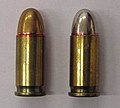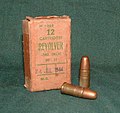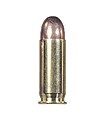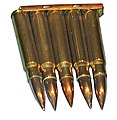Full metal jacket (ammunition): Difference between revisions
m →Disadvantages: Capitalization ("Full Metal Jacket" to "full metal jacket") |
→Disadvantages: copy edit |
||
| Line 5: | Line 5: | ||
==Disadvantages== |
==Disadvantages== |
||
There are some disadvantages to jacketing a bullet.<ref>[http://www.shootersforum.com/single-shot-handguns/63988-cast-bullets-vs-full-metal-jacketed.htm Cast Bullet vs Full Metal Jacketed]</ref> For instance, full metal jacket bullets have different properties, both in terms of behavior inside the barrel of the gun and also in flight. Whereas hollow point and soft-tipped bullets are designed to expand upon impact, full metal jacket bullets are limited in their capacity to expand. This makes the bullet pierce through, in many cases |
There are some disadvantages to jacketing a bullet.<ref>[http://www.shootersforum.com/single-shot-handguns/63988-cast-bullets-vs-full-metal-jacketed.htm Cast Bullet vs Full Metal Jacketed]</ref> For instance, full metal jacket bullets have different properties, both in terms of behavior inside the barrel of the gun and also in flight. Whereas hollow point and soft-tipped bullets are designed to expand upon impact, full metal jacket bullets are limited in their capacity to expand. This makes the bullet pierce through, in many cases leading to decreased target damage. Hollow point and soft tipped bullets are for use against soft targets only, such as animals or people, whereas Full Metal Jacket bullets can be indiscriminately used against soft and hard targets, delivering sub-optimal damage to both kinds of targets. Jacketed bullets require a certain velocity for proper expansion based on their size, and a larger quantity of [[gunpowder]] must be used. They are the most expensive bullets, followed by plated bullets and lastly, cast bullets. Jacketed bullets are also bulkier, heavier, and more difficult to carry as they have a larger volume. Rifles using this bullet employ a large [[speedloader]] magazine. |
||
== FMJ with variable cores == |
== FMJ with variable cores == |
||
Revision as of 14:58, 2 February 2012

A full metal jacket (or FMJ) is a bullet consisting of a soft core (usually made of lead) encased in a shell of harder metal, such as gilding metal, cupronickel or less commonly a steel alloy. This shell can extend around all of the bullet, or often just the front and sides with the rear left as exposed lead. (A bullet that is completely enclosed by the shell is alternatively termed a total metal jacket round.) The jacket allows for higher muzzle velocities than bare lead without depositing significant amounts of metal in the bore. It also prevents damage to bores from steel or armor-piercing core materials. The appearance of FMJ ammunition is highly distinctive when compared to hollow-point or soft point bullets. Historically, the first successful full metal jacket rifle bullets were invented by Lt. Col. Eduard Rubin of the Swiss Army in 1882.[1][2][3][4] Full metal jacket bullets were first used as standard ammunition in 1886, for the French Mle 1886 Lebel rifle.[citation needed]
Disadvantages
There are some disadvantages to jacketing a bullet.[5] For instance, full metal jacket bullets have different properties, both in terms of behavior inside the barrel of the gun and also in flight. Whereas hollow point and soft-tipped bullets are designed to expand upon impact, full metal jacket bullets are limited in their capacity to expand. This makes the bullet pierce through, in many cases leading to decreased target damage. Hollow point and soft tipped bullets are for use against soft targets only, such as animals or people, whereas Full Metal Jacket bullets can be indiscriminately used against soft and hard targets, delivering sub-optimal damage to both kinds of targets. Jacketed bullets require a certain velocity for proper expansion based on their size, and a larger quantity of gunpowder must be used. They are the most expensive bullets, followed by plated bullets and lastly, cast bullets. Jacketed bullets are also bulkier, heavier, and more difficult to carry as they have a larger volume. Rifles using this bullet employ a large speedloader magazine.
FMJ with variable cores
Some designs of FMJ rifle ammunition inflict more destructive gunshot wounds than others. Not all FMJ bullets contain a simple lead filling. Here are some examples:
Although British Mark 7 .303 ammunition is compliant with the terms of the Hague Convention, it creates more destructive gunshot wounds than standard spitzer bullets due to its internal design. The centre of gravity of the Mark 7 bullet is deliberately shifted towards the rear. This is achieved by constructing the front third of the interior of the bullet from a lighter material such as aluminium or wood pulp. The result is a tail-heavy FMJ bullet which yaws violently after hitting the target. The .303 British Mark 7 ammunition has been replaced by the 7.62x51mm NATO.
Images of FMJ ammunition
-
7.92×57mm Mauser dated 1941
-
Three recovered 7.62×51mm NATO FMJ bullets (next to an unfired cartridge), showing rifling marks
See also
References
- ^ (Huon,1988)
- ^ Swissrifles.com
- ^ Holt Bobinson "The model 1911 Schmidt Rubin: the other Switzer". Guns Magazine. FindArticles.com. 08 Jun, 2010. http://findarticles.com/p/articles/mi_m0BQY/is_11_54/ai_n28573712/
- ^ The Gun Digest Book of Firearms Assembly/Disassembly: Centerfire Rifles, Volume 4 by J. B. Wood. Published by Krause Publications, 2003. ISBN 9780873496315
- ^ Cast Bullet vs Full Metal Jacketed
- Huon, Jean (1988). Military Rifle and Machine Gun Cartridges. Alexandria, Va.: Ironside International. ISBN 093555405X. OCLC 24498827.
External links
- Declaration (IV, 3) concerning Expanding Bullets, made at the 1899 International Peace Conference at The Hague, which entered into force on September 4, 1900
- European Ammunition Box Translations
- Photos showing terminal effects of British Mark 7 .303 bullets



















